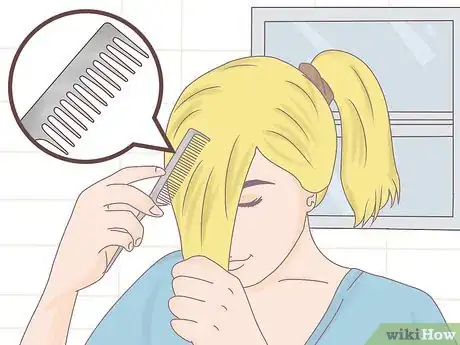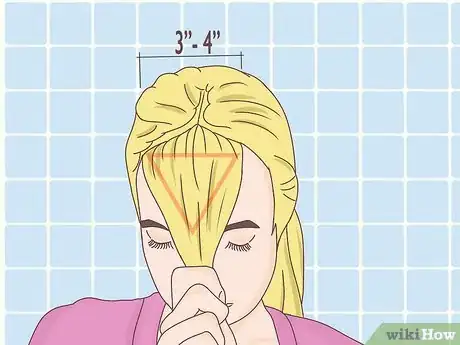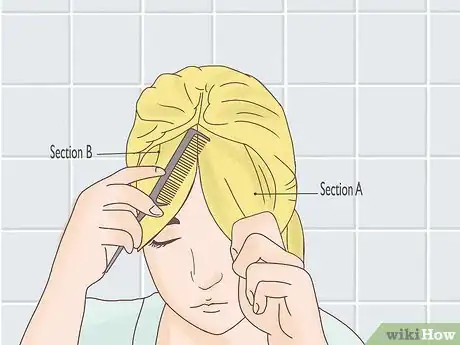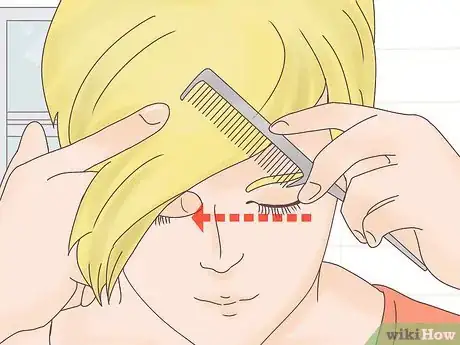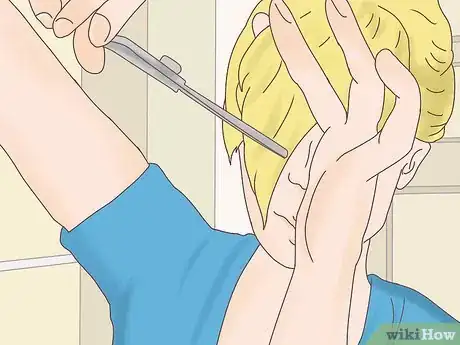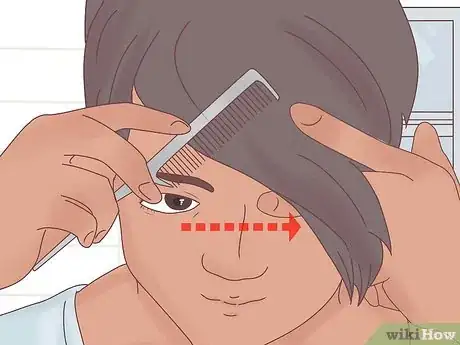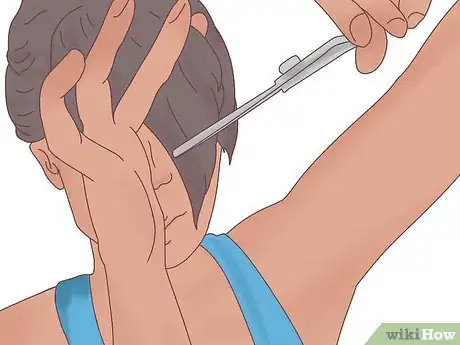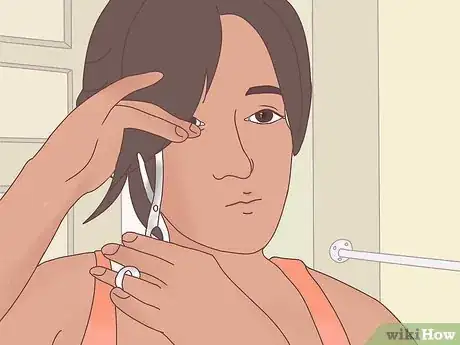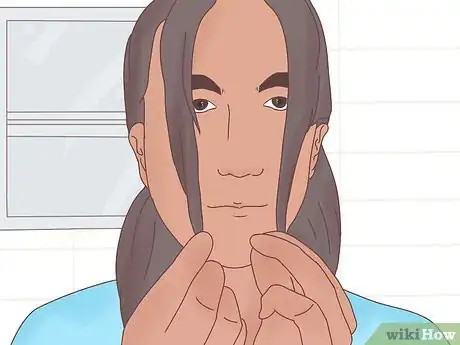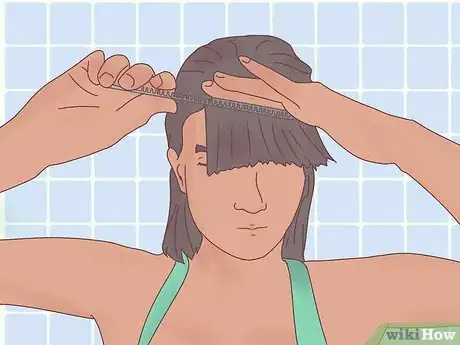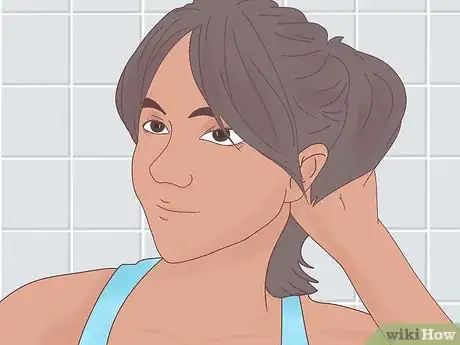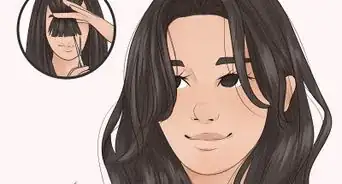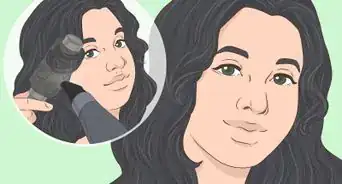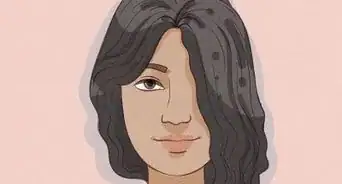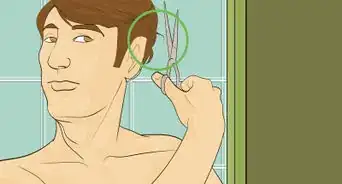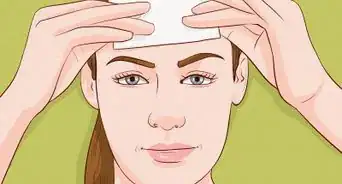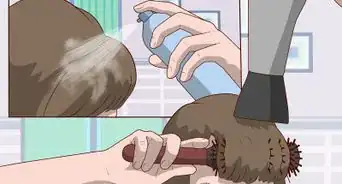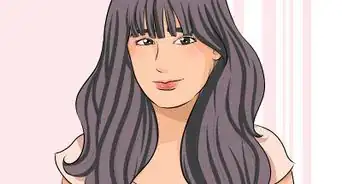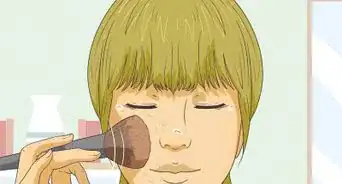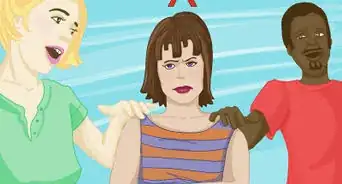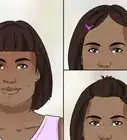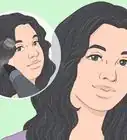This article was co-authored by Brianna Bowling and by wikiHow staff writer, Janice Tieperman. Brianna Bowling is a Hair Stylist and the Co-Owner of The CRAFT Salon in Glendora, California. With more than 11 years of experience, she specializes in balayage, blonding, and vivid colors. Brianna has received years of in-depth training on advanced color techniques.
There are 17 references cited in this article, which can be found at the bottom of the page.
This article has been viewed 39,767 times.
Not to be confused with layered bangs, shaggy bangs (otherwise known as curtain or Bardot bangs) are a relaxed and elegant hairstyle that frame your face at a downward angle. While it’s always best to consult a professional hairstylist with any major hair changes, you can make your own adjustments with a set of trimming or texturizing shears. With patience and precision, you can create a fun new look for yourself!
Steps
Trimming the First Section
-
1Comb your bangs in front of your face with a wide-toothed comb. Brush through your hair to remove any tangles or snares. Instead of brushing some hair to the side, use a wide-toothed comb to arrange your future bangs in front of your forehead and eyes.[1]
- This process helps you visualize how much hair you have to work with, and makes it easier to section off your bangs.
-
2Separate off a triangular portion of hair in front of your forehead. Use your comb to section off a 3 to 4 in (7.6 to 10.2 cm) section of hair in front of your forehead and eyes.[2] Make sure that the section of hair falls about 3 in (7.6 cm) into your hairline so your bangs are thick enough to frame your face.[3]
- If you have thinner hair, you might want to section off a portion of hair that falls around 4 in (10 cm) into your hairline.
- When sectioned off, this portion of hair should form an angled, triangular shape along your hairline.
Advertisement -
3Split this portion of hair into 2 even sections, A and B. Use a comb to divide your bangs down the center of your forehead. Before you start trimming or adjusting your bangs, check both sides to ensure that your shaggy bangs will have equal amounts of hair.[4] To prevent confusion later on, label the leftmost portion of hair as section A, and the rightmost portion as section B.[5]
- Since these bangs will be framing your face, you want them to look as even as possible.
-
4Brush section A to the right side of your head. Pinch the hair between your pointer and middle finger, then drag your comb through section A. Pull this portion of hair next to section B. At this point, use your pinched fingers to figure out how much hair you want to trim away.[6]
- Try to keep around 1 to 2 in (2.5 to 5.1 cm) of hair dangling beneath your fingers.[7]
- Pinch more hair than you plan on trimming overall.
- Pulling your bangs to the right makes it easier for you to see and trim them.
-
5Cut the bangs at a downward angle in small increments.[8] Use a pair of scissors or texturizing shears to make small adjustments to the hair dangling beneath your pinched fingers. Trim your hair in short, vertical or angled motions so you can create a balanced, feathery effect along the edge of your shaggy bangs. Don’t cut the entire section of pinched hair—instead, trim away a few millimeters at a time.[9]
- Try to avoid making 1 horizontal cut, as this type of trimming won’t be as precise.
-
6Trim the edge of section A to make it look smoother. Pinch the bottom 1 in (2.5 cm) of your hair to create more exact adjustments to section A of your bangs. Drag your trimming shears in slow, angled motions to even out the edge of your bangs.[10]
- At this point, the shortest portion of your bangs will be around eye level, while the longest portion will be close to your chin.
Adjusting the Second Section
-
1Transfer 1 of the shortest tendrils of hair from section A to B. Pinch a small, 5 to 10 mm section of the shortest hair from the right side of section A. Move this small portion of hair over to section B, so you have a reference of how short your bangs need to be.[11]
- This process helps both of your bangs to look more exact.
-
2Comb section B to the left side of your head. Pinch section B between your pointer and middle finger, then pull it toward section A. Drag your comb through this portion of hair to ensure that both sections of hair are relatively even in length.[12]
-
3Pinch your hair and cut it at a downwards angle. Hold section B tightly between your pointer and middle fingers, leaving about 1 to 2 in (2.5 to 5.1 cm) of hair dangling beneath your fingers. With your shears, trim the hair at a 45-degree angle to shape and angle the hair. Try to use light, gentle motions to trim the hair so you can make adjustments later.[13]
- Sections A and B will be mirror images of one another.
-
4Cut your bangs vertically to make small adjustments. Continue holding section B between your pointer and middle fingers and look for any uneven sections of hair. Make the edge of your bangs even by trimming the bottom edge with short, vertical motions.[14]
- Vertical cuts help you make more precise adjustments to your bangs.
-
5
-
6Brush and trim your bangs to make any necessary adjustments. Use your wide-toothed comb to smooth out your newly trimmed bangs. Once you’ve done this, use your trimming or texturizing shears to trim the bottom, angled edge of your shaggy bangs with short, vertical motions. Make small adjustments until you’re happy with the way your bangs look.[17]
- You can always cut away extra hair, but you can’t add extra hair back to your bangs. Keep this in mind as you cut!
-
7Style your bangs to the sides of your head so they blend with your hair. Comb section A to the left side of your face, and section B to the right side. You can also use a curling iron to add more lift and style to your bangs.[18]
Tip: You can also use a large, round brush to help style your bangs! Comb through your bangs from left to right, then brush them directly in front of your forehead. At this point, you can brush your bangs to the left and right to frame your face![19]
Expert Q&A
-
QuestionHow do you cut bangs for beginners?
 Brianna BowlingBrianna Bowling is a Hair Stylist and the Co-Owner of The CRAFT Salon in Glendora, California. With more than 11 years of experience, she specializes in balayage, blonding, and vivid colors. Brianna has received years of in-depth training on advanced color techniques.
Brianna BowlingBrianna Bowling is a Hair Stylist and the Co-Owner of The CRAFT Salon in Glendora, California. With more than 11 years of experience, she specializes in balayage, blonding, and vivid colors. Brianna has received years of in-depth training on advanced color techniques.
Hair Stylist Use a point cutting technique! Hold the scissors parallel to your nose and make small, vertical cuts rather than cutting straight across.
Use a point cutting technique! Hold the scissors parallel to your nose and make small, vertical cuts rather than cutting straight across.
Things You’ll Need
- Wide-toothed comb
- Trimming shears
- Mirror
- Texturizing shears (optional)
- Curling iron (optional)
References
- ↑ https://m.youtube.com/watch?v=Z4e3BSsvUgc&t=8m8s
- ↑ https://m.youtube.com/watch?v=mwnmuNgSlBM&t=1m2s
- ↑ https://m.youtube.com/watch?v=1EMr7IpU0bE&t=3m36s
- ↑ Brianna Bowling. Hair Stylist. Expert Interview. 25 February 2022.
- ↑ https://m.youtube.com/watch?v=2xw3a5jjJnw&t=1m12s
- ↑ https://m.youtube.com/watch?v=2xw3a5jjJnw&t=1m14s
- ↑ https://m.youtube.com/watch?v=mwnmuNgSlBM&t=2m12s
- ↑ Brianna Bowling. Hair Stylist. Expert Interview. 25 February 2022.
- ↑ https://m.youtube.com/watch?v=mwnmuNgSlBM&t=2m19s
- ↑ https://m.youtube.com/watch?v=2xw3a5jjJnw&t=2m1s
- ↑ https://m.youtube.com/watch?v=2xw3a5jjJnw&t=3m27s
- ↑ https://m.youtube.com/watch?v=mwnmuNgSlBM&t=2m33s
- ↑ https://m.youtube.com/watch?v=2xw3a5jjJnw&t=3m32s
- ↑ https://m.youtube.com/watch?v=1EMr7IpU0bE&t=5m8s
- ↑ Brianna Bowling. Hair Stylist. Expert Interview. 25 February 2022.
- ↑ https://m.youtube.com/watch?v=2xw3a5jjJnw&t=4m8s
- ↑ https://m.youtube.com/watch?v=2xw3a5jjJnw&t=4m52s
- ↑ https://m.youtube.com/watch?v=2xw3a5jjJnw&t=5m8s
- ↑ https://www.rachaelrayshow.com/articles/the-trick-to-pulling-off-curtain-bangs-according-to-a-celebrity-stylist
